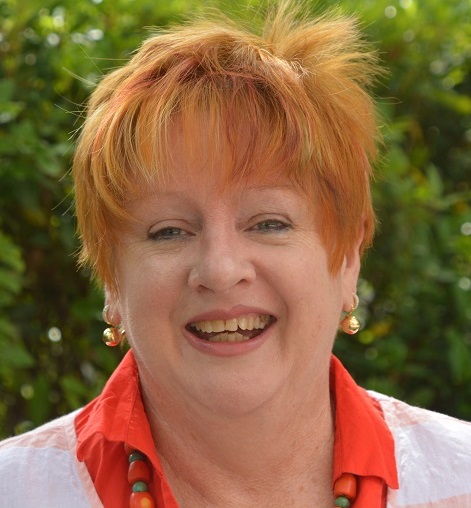February 2018 Featured Educator: Kay Mitchell

Where do you teach? What grades? How long have you been a teacher and how long have you been at your current school?
I've been teaching in International Baccalaureate (IB) international schools in Viet Nam, China, Japan and Qatar since 2002. Prior to that, I taught in government schools in Australia, Viet Nam and Indonesia. I was also a professional development (PD) officer for Asian Studies for seven years. I'm trained as a secondary EAL (English as an Additional Language) teacher but have also had the privilege of teaching primary aged students as well as adults in tertiary accredited EAL PD courses.
What is your class, school and district like? Can you tell me a little about its location, size and about the composition of the student body? What do language services look like in your school?
Currently, I'm taking a few months leave from teaching but as always, there are opportunities to keep my hand in by presenting EAL strategies workshops for teachers. I'm looking forward to starting teaching again in the new school year.
Language support for students is dependent on their needs and the resources available in the school. For ALL language learners, there should be a time and space for them to learn about language in a safe environment where they can be risk-takers with their learning. It's important for beginning learners to feel success with their rate of learning and this is often best achieved with a good buddy and a dedicated time for learning the language. Younger students generally need less time for this than older ones.
Why are you an educator? What do you love about your job? What frustrates you?
I fell into education after talking with my aunt who was an EAL teacher working with refugee children. Her story of teaching a former child soldier really piqued my interest. While I've not worked for a long time with refugee children, as an educator, there is always the sense of making a difference. It's not always evident, but with perseverance, consistency, and a caring attitude, "the water will make its mark on the stone."
The biggest frustration is the misconception among English speakers that non-English speakers somehow have a "deficit." And sadly, very often, this deficit notion comes from monolinguals! Instead of equating a low level of English as the glass half empty, we should be celebrating the diversity and accomplishments which are the hidden part of the iceberg that we ALL are – the 90% hidden below the surface.
When you see or hear someone struggling to express their thoughts in English while translating from another language/s, remember that it could be that English just doesn't have the vocabulary to precisely describe the concept. It could be that there isn't a corresponding English word. The range of English vocabulary could be the deficit, not the English language learner! The best administrators I have worked with understand this and recognize that strong support from administration for EAL expertise is vital.
What is your approach in your classroom/school towards language learning? What techniques/strategies have you found to be most effective in teaching language learners?
The best method is to give students the tools to effectively develop their own communication in English-using English as a semiotic system. Functional grammar gives them the tools to scale up and down from formal to informal communication within the cultural context. It makes explicit the often hidden realms of English-register and the grammar choices affecting register. Giving students the power to engage at their own level and pace is a method that I find most effective. Finding a student's interests and their need to communicate this interest is the key to their rapid language acquisition. YouTube is very useful because it appeals to most students' learning style and there is a video on almost any topic!
How do you determine/decide what language to focus on in a lesson? Describe your planning process to address the needs of your students, if possible.
I have students keep a journal where they reflect on what they've achieved and what they'd like to achieve in the following week or lesson. This not only gives me insight into the mechanics of their language use but also into their interests. This then frames the upcoming group activities within the unit. I also ensure that beginning students are grouped with intermediate and intermediate are grouped with more advanced learners, rather than beginners and advanced together. The ZPD is very important in learning language; it keeps motivation levels going.
How do you encourage students to learn? How do you accelerate their language development and ensure their equitable access to content learning?
I encourage students to be risk-takers with language. Many students find that by seeking out patterns in language, they can approximate most new word forms or sentence structures. Additionally, by comparing how English language forms are similar or dissimilar to their home language, students develop deeper understandings of both languages. For many students in international schools who will be returning to their home country for tertiary studies, this is a critical aspect of language learning.
I often ask older students to research and write up their findings in their home language. By writing the key words in both languages, they identify what they have learned in English. Using tools like Google Voice typing, students can check their vocabulary, sentence structure, and pronunciation. At first, this requires quite intensive teacher support. But, as students realize the value of this tool, it becomes a good way of starting drafts for assessment in any subject area.
The best way to ensure that there is equitable access to content learning is to provide training for mainstream teachers in EAL strategies and to support mainstream teachers in developing EAL skills. It's just not possible for the EAL teacher to support all students who need support in every class. But, it is possible to provide support and training for mainstream teachers, which will allow for more equitable access.
How do you assess your students' language learning?
Students should be part of an ongoing process of assessment. Using a range of formative and summative tasks, which focus on the four macro skills of listening, speaking, reading and writing, a student can build a portfolio of their work from across the curriculum. Students can get immediate feedback, as well as a goal for self-evaluation, with the help of a rubric that outlines the different levels for each task.
What unique challenges or opportunities come with teaching English in an international setting?
Teaching English in an international setting provides so many opportunities for both students and teachers to learn from each other. In general, both the student and educator population are transient, many spending only two to five years in the same school. For beginning English students who arrive in a new country, new culture, and new school with no friends or familiar faces, the prospect of the first days and weeks is often overwhelming. It's how these students are supported to succeed to the best of their ability that makes a daunting experience into a positive life-changing experience.
One student was a source of great anguish for me when she arrived. For over three months, she would arrive in the EAL class, slump to the floor and sob. Sometimes, she would sob until she hiccupped. It was heart wrenching but I carried on and jollied her through each day. Fortunately, she slowly became involved in the school community and after the first holiday back home, returned with renewed enthusiasm and purpose. By the time the family left the school five years later, this girl was student council president, a sporting representative and very active in the community service team. Having to return to their home country, both mother and daughter were again in draughts of tears, but this time, they had strategies to make the transition easier. It's these interactions which makes the life of an international educator so rich – not monetarily, but in the sense of job satisfaction. Living and working in different countries and cultures provides personal and professional challenges and rewards that generally just don't happen easily within one's own community.





